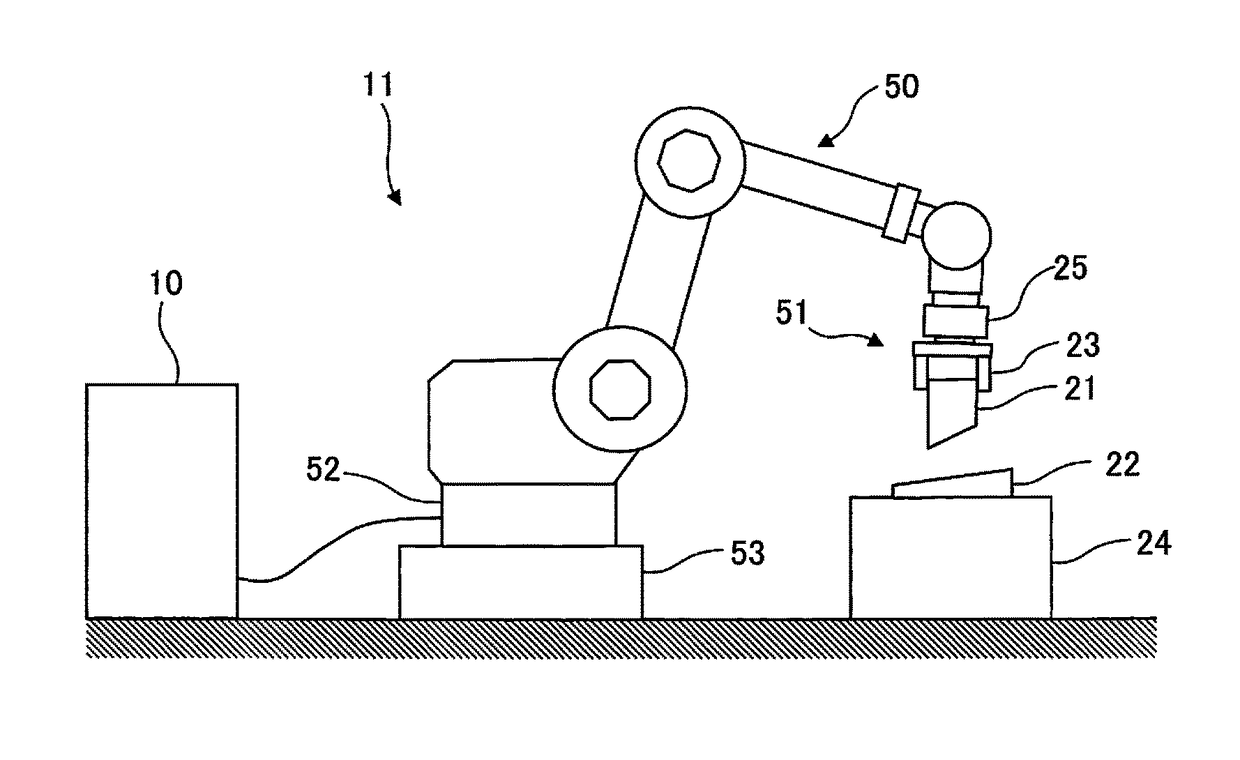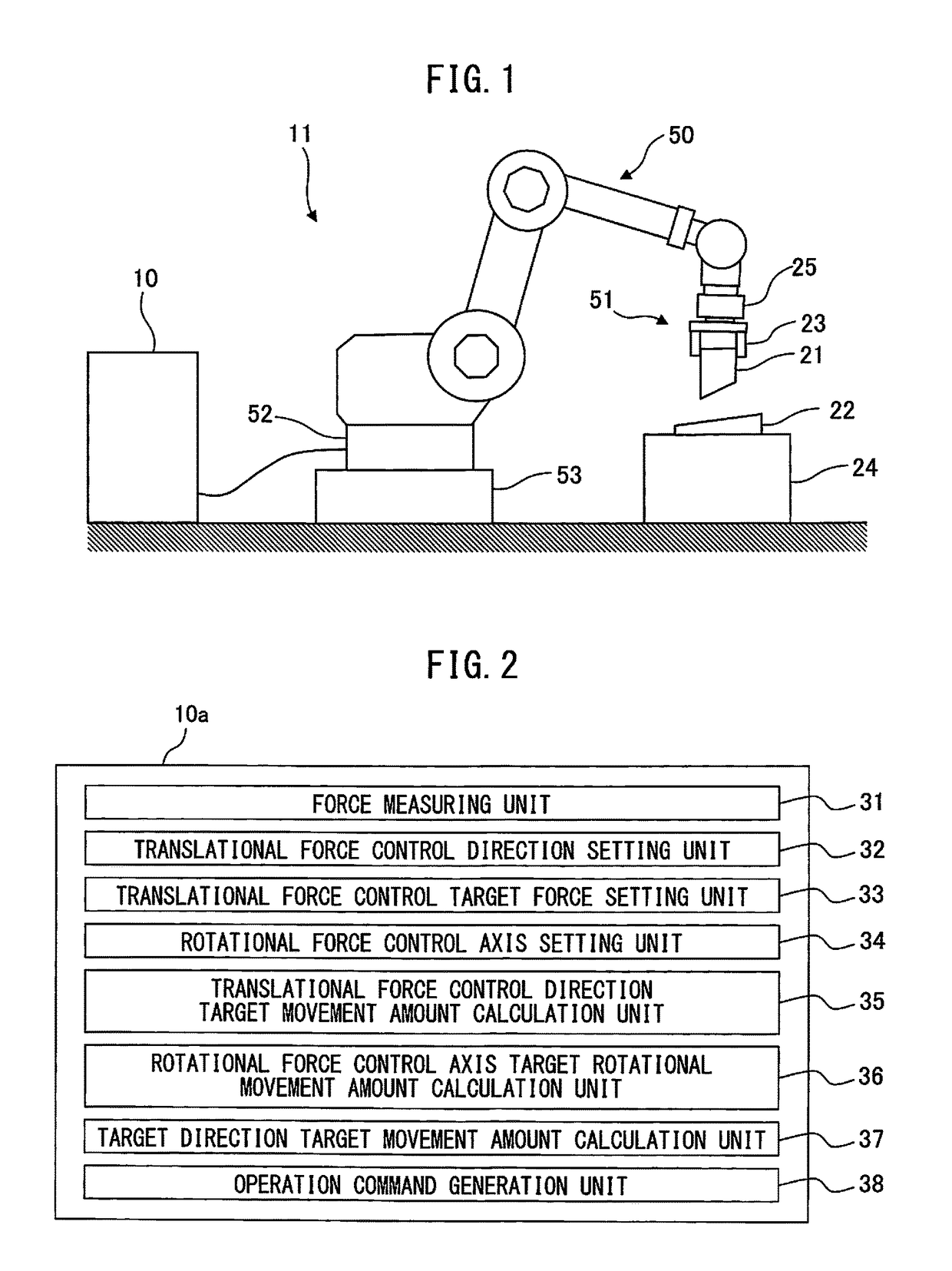Robot controller for robot which sets two objects in combined state
a robot controller and combined state technology, applied in the field of robot controllers, can solve the problems of difficult to achieve smooth convergence to the above-mentioned state, easy to noise or vibration or take a small value of the force about the axis of rotation,
- Summary
- Abstract
- Description
- Claims
- Application Information
AI Technical Summary
Benefits of technology
Problems solved by technology
Method used
Image
Examples
first embodiment
[0079]FIG. 2 is a block diagram functionally illustrating the configuration of a robot controller 10a according to the present invention. The robot controller 10a includes a force measuring unit 31, a translational force control direction setting unit 32, a translational force control target force setting unit 33, a rotational force control axis setting unit 34, a translational force control direction target movement amount calculation unit 35, a rotational force control axis target rotational movement amount calculation unit 36, a target direction target movement amount calculation unit 37, and an operation command generation unit 38, as illustrated as FIG. 2. The robot controller 10 further includes a storage unit and a signal output unit which outputs various signals, although not illustrated.
[0080]The force measuring unit 31 measures a force acting between the given object 21 held on the end effector 51 of the robot 50 and the different object 22. In doing this, a force translat...
fourth embodiment
[0188]FIGS. 18a to 18e are partial enlarged views illustrating an operation for setting the given object 21 and the different object 22 in a combined state by the robot controller 10 according to the present invention. FIG. 18a illustrates the state at the start of movement to set the given object 21 and the different object 22 in a combined state, a predetermined direction independent of the moving operation of the given object 21 is set as a direction of translational force control 61, and an axis which runs in a predetermined direction independent of the moving operation of the given object 21 and passes through a control point for the given object 21 is set as an axis of rotational force control 62. The direction of translational force control of the given object 21 relative to the different object 22 may be changed, instead of a predetermined direction, as in other embodiments. As the given object 21 is translated relative to the different object 22 in the direction of translat...
third embodiment
[0189]Next, the given object 21 is moved to change the contact position for the different object 22, as illustrated as FIG. 18c. At this time, the given object 21 is moved in the direction of translational force control 61 while rotating it about the axis of rotational force control 62 so that the contact position for the different object 22 changes. In the above-mentioned movement, the given object 21 may be moved relative to the different object 22 in a direction of translation, such as a direction perpendicular to the direction of translational force control 61, so that the contact position for the different object 22 changes. As described in conjunction with the robot controller 10 according to the present invention, the given object 21 may be moved about an axis of rotational force control, which is set to pass through a predetermined position specified for the given object 21 or the different object 22, such as the position at which the given object 21 and the different object...
PUM
 Login to View More
Login to View More Abstract
Description
Claims
Application Information
 Login to View More
Login to View More - R&D
- Intellectual Property
- Life Sciences
- Materials
- Tech Scout
- Unparalleled Data Quality
- Higher Quality Content
- 60% Fewer Hallucinations
Browse by: Latest US Patents, China's latest patents, Technical Efficacy Thesaurus, Application Domain, Technology Topic, Popular Technical Reports.
© 2025 PatSnap. All rights reserved.Legal|Privacy policy|Modern Slavery Act Transparency Statement|Sitemap|About US| Contact US: help@patsnap.com



